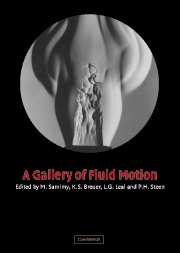1 - Jets and mixing layers
Published online by Cambridge University Press: 25 January 2010
Summary
Laser-induced fluorescence (LIF) diagnostics and highspeed, real-time digital image acquisition techniques are combined to map the composition field in a water mixing layer. A fluorescent dye, which is premixed with the lowspeed freestream fluid and dilutes by mixing with the highspeed fluid, is used to monitor the relative concentration of high-speed to low-speed fluid in the layer.
The three digital LIF pictures shown here were obtained by imaging the laser-induced fluorescence originating from a collimated argon ion laser beam, extending across the transverse dimension of the shear layer, onto a 512–element linear photodiode array. Each picture represents 384 contiguous scans, each at 400 points across the layer, for a total of 153 600 point measurements of concentration. The vertical axis maps onto 40 mm of the transverse coordinate of the shear layer, and the horizontal axis is time increasing from right to left for a total flow real time of 307 msec. The pseudocolor assignment is linear in the mixture fraction (ξ) and is arranged as follows: red-unmixed fluid from the low-speed stream (ξ=0); blue-unmixed fluid from the high-speed stream (ξ=1); and the rest of the spectrum corresponds to intermediate compositions.
Figures 1 and 2, a single vortex and pairing vortices, respectively, show the composition field before the mixing transition. The Reynolds number based on the local visual thickness of the layer and the velocity difference across the layer is Re=1750 with U2/U1=0.46 and U1=13 cm/sec. Note the large excess of high-speed stream fluid in the cores of the structures.
- Type
- Chapter
- Information
- A Gallery of Fluid Motion , pp. 1 - 10Publisher: Cambridge University PressPrint publication year: 2004



